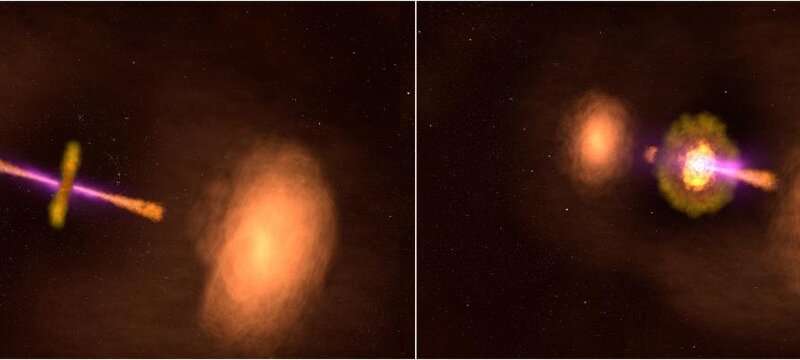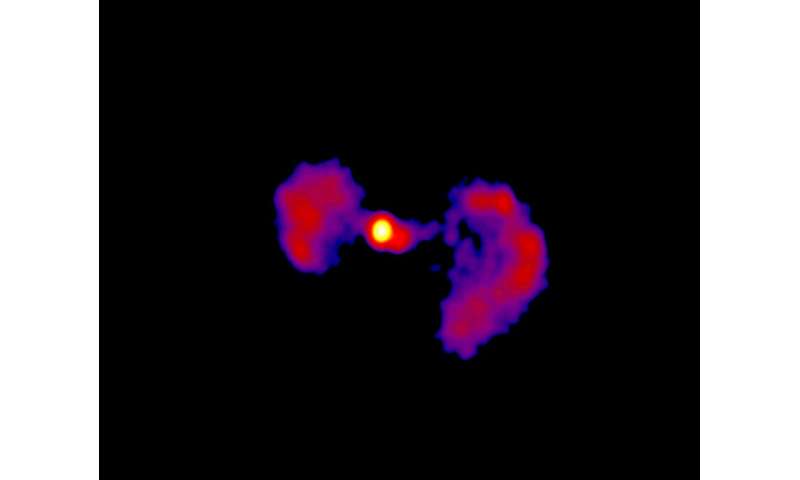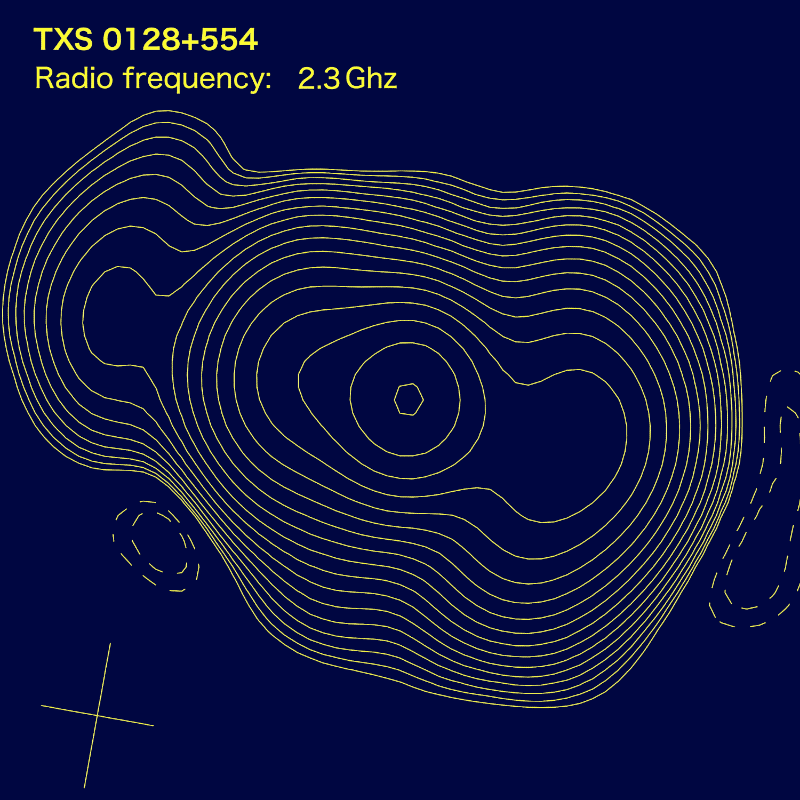NASA missions discover a ‘TIE fighter’ energetic galaxy

Not so way back, astronomers mapped a galaxy far, distant utilizing radio waves and located it has a strikingly acquainted form. Within the course of, they found the item, known as TXS 0128+554, skilled two highly effective bouts of exercise within the final century.
Round 5 years in the past, NASA’s Fermi Gamma-ray House Telescope reported that TXS 0128+554 (TXS 0128 for brief) is a faint supply of gamma rays, the highest-energy type of mild. Scientists have since taken a more in-depth look utilizing the Very Lengthy Baseline Array (VLBA) and NASA’s Chandra X-ray Observatory.
“After the Fermi announcement, we zoomed in one million occasions nearer on the galaxy utilizing the VLBA’s radio antennas and charted its form over time,” mentioned Matthew Lister, a professor of physics and astronomy at Purdue College in West Lafayette, Indiana. “The primary time I noticed the outcomes, I instantly thought it regarded like Darth Vader’s TIE fighter spacecraft from ‘Star Wars: A New Hope.’ That was a enjoyable shock, however its look at completely different radio frequencies additionally helped us be taught extra about how energetic galaxies can change dramatically on decade time scales.”
A paper describing the findings, led by Lister, was printed within the Aug. 25 difficulty of the Astrophysical Journal and is now out there on-line.
TXS 0128 lies 500 million light-years away within the constellation Cassiopeia, anchored by a supermassive black gap round 1 billion occasions the Solar’s mass. It is categorised as an energetic galaxy, which implies all its stars collectively cannot account for the quantity of sunshine it emits.
An energetic galaxy’s further power consists of extra radio, X-ray, and gamma-ray mild. Scientists assume this emission arises from areas close to its central black gap, the place a swirling disk of gasoline and dirt accumulates and heats up due to gravitational and frictional forces.

Round one-tenth of energetic galaxies produce a pair of jets, beams of high-energy particles touring at almost the pace of sunshine in reverse instructions. Astrophysicists assume these jets produce gamma rays. In some circumstances, collisions with tenuous intergalactic gasoline ultimately gradual and halt the outward movement of jet particles, and the fabric begins to circulate again towards the galaxy’s middle. This leads to broad areas, or lobes, stuffed with fast-moving particles spiraling round magnetic fields. The particle interactions create vivid radio emission.
Fermi has recognized over 3,000 energetic galaxies utilizing its Giant Space Telescope, which surveys the whole sky each three hours. Practically all of them are aligned in order that one jet factors nearly instantly at Earth, which boosts their indicators. TXS 0128, nevertheless, is round 100,000 occasions much less highly effective than most of them. The truth is, although it is comparatively close by, Fermi wanted to build up 5 years of knowledge from the galaxy earlier than reporting it as a gamma-ray supply in 2015.
Researchers then added the galaxy to a long-running survey performed by the VLBA, a community of radio antennas operated by the Nationwide Radio Astronomy Observatory stretching from Hawaii to the U.S. Virgin Islands.
The array’s measurements present an in depth map of TXS 0128 at completely different radio frequencies. The radio construction they revealed spans 35 light-years throughout and tilts about 50 levels out of our line of sight. This angle means the jets aren’t pointed instantly at us and will clarify why the galaxy is so dim in gamma rays.
“The true-world universe is three-dimensional, however after we look out into area, we normally solely see two dimensions,” mentioned Daniel Homan, a co-author and professor of astronomy at Denison College in Granville, Ohio. “On this case, we’re fortunate as a result of the galaxy is angled in such a approach, from our perspective, that the sunshine from the farther lobe travels dozens extra light-years to succeed in us than the sunshine from the nearer one. This implies we’re seeing the farther lobe at an earlier level in its evolution.”
If the galaxy was aligned so the jets and lobes had been perpendicular to our line of sight, all the sunshine would attain Earth on the identical time. We might see either side on the identical stage of growth, which they’re in actuality.

The galaxy’s obvious form depends upon the radio frequency used. At 2.Three gigahertz (GHz), about 21 occasions higher than the utmost broadcast frequency of FM radio, it seems like an amorphous blob. The TIE fighter form emerges at 6.6 GHz. Then, at 15.Four GHz, a transparent hole within the radio emission seems between the galaxy’s core and its lobes.
Lister’s workforce suspects a lull in TXS 0128’s exercise created this hole. The galaxy’s jets seem to have began round 90 years in the past, as noticed from Earth, after which stopped about 50 years later, forsaking the unconnected lobes. Then, roughly a decade in the past, the jets turned on once more, producing the emission seen nearer to the core. What precipitated the sudden onset of those energetic intervals stays unclear.
The radio emission additionally sheds mild on the situation of the galaxy’s gamma-ray sign. Many theorists predicted that younger, radio-bright energetic galaxies produce gamma rays when their jets collide with intergalactic gasoline. However in TXS 0128’s case, a minimum of, the particles within the lobes do not produce sufficient mixed power to generate the detected gamma rays. As an alternative, Lister’s workforce thinks the galaxy’s jets produce gamma rays nearer to the core, like the vast majority of energetic galaxies Fermi sees.
The workforce noticed the galaxy in X-rays utilizing Chandra, on the lookout for proof of an enveloping cocoon of ionized gasoline. Whereas their measurements could not affirm the presence or absence of a cocoon, there was proof for such buildings in different energetic galaxies, like Cygnus A. The observations do point out the galaxy has a considerable amount of mud and gasoline surrounding its core, which is in line with a extremely inclined viewing angle.
“This galaxy reminds us of the significance of multiwavelength observations, objects throughout a variety of the electromagnetic spectrum,” mentioned Elizabeth Hays, the Fermi mission scientist at NASA’s Goddard House Flight Middle in Greenbelt, Maryland. “Fermi, the VLBA, and Chandra every add a layer to our rising image of this object, revealing their very own surprises.”
The Fermi Gamma-ray House Telescope is an astrophysics and particle physics partnership managed by NASA’s Goddard House Flight Middle in Greenbelt, Maryland. Fermi was developed in collaboration with the U.S. Division of Power, with essential contributions from tutorial establishments and companions in France, Germany, Italy, Japan, Sweden, and the US.
NASA’s Marshall House Flight Middle manages the Chandra program. The Smithsonian Astrophysical Observatory’s Chandra X-ray Middle controls science and flight operations from Cambridge and Burlington, Massachusetts.
A galaxy’s stop-and-start younger radio jets
M. L. Lister et al. TXS 0128+554: A Younger Gamma-Ray-emitting Lively Galactic Nucleus with Episodic Jet Exercise. Revealed 2020 August 25 • 2020. The Astrophysical Journal, Quantity 899, Quantity 2
NASA’s Goddard House Flight Middle
Quotation:
NASA missions discover a ‘TIE fighter’ energetic galaxy (2020, August 25)
retrieved 25 August 2020
from https://ift.tt/34xhm05
This doc is topic to copyright. Aside from any honest dealing for the aim of personal research or analysis, no
half could also be reproduced with out the written permission. The content material is supplied for info functions solely.
The post NASA missions discover a ‘TIE fighter’ energetic galaxy appeared first on Chop News.
from Chop News https://ift.tt/3aX2AAV
via Blogger https://ift.tt/3je79tt
August 26, 2020 at 05:50AM
Post a Comment